Learn about one of the world's most dangerous snakes, the Black Mamba. We'll talk about their physical features, habitat, how they attack, and more!
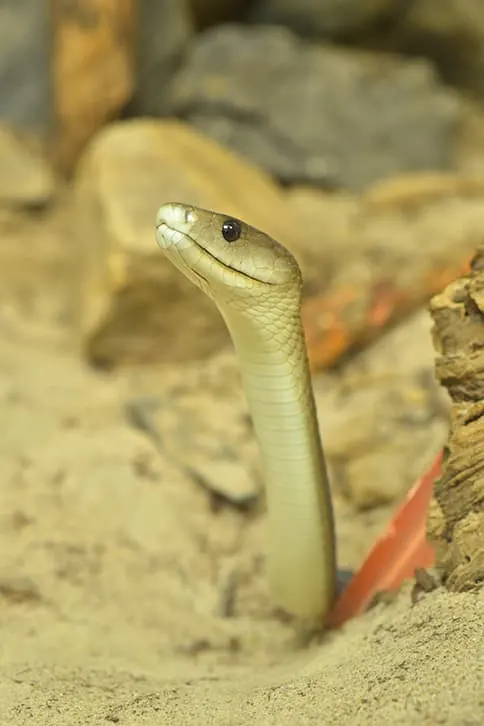
Physical Description
Black Mambas get their name after the black tint on the inside of their mouths. When a Mamba feels threatened it opens its jaws to defend itself. The black that is seen on the inside of a Mamba’s mouth acts as a warning signal.
The Black Mamba's scales range from olive to brown to gray, with a pale underbelly. The scales of a Mamba get lighter as they age. A young Mamba is much darker than a mature Mamba.
Black Mambas are sleek and powerful, reaching a maximum length of 14 feet. The average length of a Black Mamba is 8.2 feet. In comparison, the average human being stands at 5.6 feet.
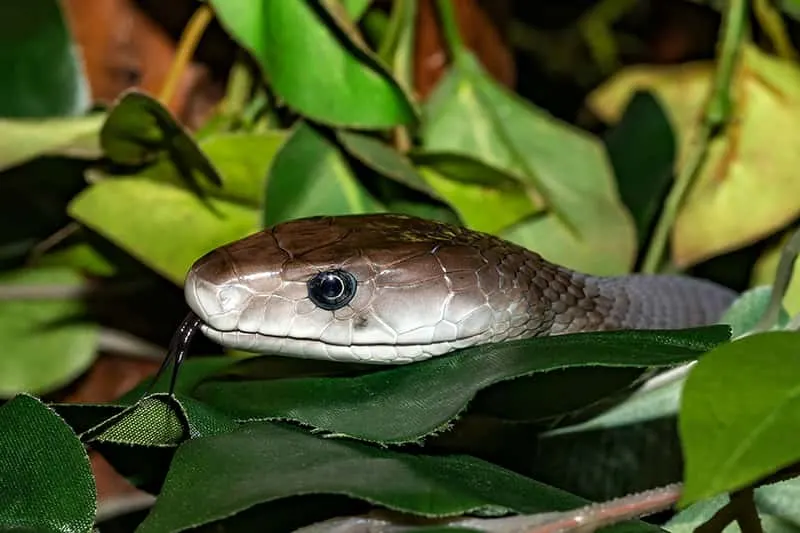
Habitat:
Africa is home to the Black Mambas. These snakes live in Sub-Saharan Africa. The habitat of the Black Mamba ranges from Southern Ethiopia to Southwest Africa.
Black Mamba’s prefer low open spaces. They sleep in hollow trees, rocks, burrows, and empty termite mounds. They are the only species of Mamba that does not spend most of its time in trees.
When homes are newly built in a Black Mamba’s habitat, people are terrified when the snake enters their home. Eventually Black Mamba’s will move out of the area that those people moved into.
Habits:
Three characteristics set Black Mamba snakes apart. They are one of the deadliest snakes on the planet, one of the longest snakes on the planet, and one of the fastest snakes on the planet.
Black Mambas are highly unpredictable and don’t like humans coming closer than 40 feet. Mambas are seldom aggressive, but they are dangerous. Black Mambas are shy and prefer to escape and hide. They will immediately attack if they feel threatened.
When a Black Mamba confronts a human, it exhibits a threat display. It lifts its head and a portion of its body off the ground, stretches its neck flap, and hisses while opening its black mouth. If the human doesn't run away, the Black Mamba will strike again and again. More poisonous venom is injected into the victim with each bite.
Just two droplets of a Mamba's venom are enough to kill a human. The average Black Mamba has a supply of 12-20 drops in each fang. First the venom makes the victim nauseous. Then, the victim will not be able to breath. Finally, the victim becomes paralyzed and dies.
It takes between 20 minutes – 3 hours for victims to die from the bite of a Black Mamba if they don’t receive an anti-dote.
Black Mambas are capable of slithering at speeds of up to 12 miles per hour, which is quicker than most humans can run. Black Mambas crawl in short bursts with their heads held high while raising a third of their bodies off the ground.
A Black Mamba is frightening to watch as it slithers rapidly with its head nearly four feet in the air. Black Mamba’s use their speed to escape, not attack.
Although Black Mambas have been recorded in pairs and small groups, they are not social creatures.
Mambas, like other reptiles, are cold-blooded. They wait until the morning warms up before leaving their shelter to hunt. Mamba’s will bask in the sun or retreat to their shelter if it gets too hot. They return to sleep in their home when the sun sets.
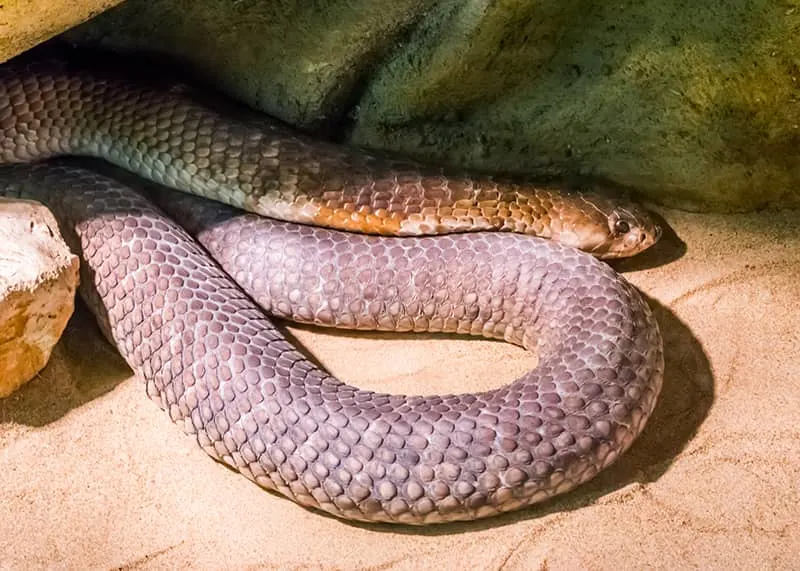
Diet:
As a carnivore, the Black Mamba's diet consists primarily of small mammals, rodents, and birds. However, Black Mambas have been known to consume entire parrots and adult cobras. A Black Mamba will bite its prey and then wait until the prey is paralyzed or dies before swallowing it.
To feed, the Black Mamba dislocates its jaw. The dislocated jaw generates a space large enough for the Mamba to swallow its prey whole. A Mamba only needs food once or twice a week and can survive without water for several months.
Offspring:
Male Mambas begin tracking the scent of a female Mamba in the late spring or early summer breeding season. If there is more than one male Mamba in the area, they will fight for the female's affection. The male leaves the area after mating.
The Black Mamba female lays between 6 and 25 eggs. After laying the eggs in a moist, warm burrow, the female leaves and does not return.
Black Mamba snakelets hatch about three months later and are between 16 and 24 inches long at birth. Snakelets are born with the ability to bite and inject a small amount of venom. Mamba juveniles grow quickly, reaching a maximum length of 6 feet in only one year. Mamba juveniles are reported to be quite nervous. They are certainly as dangerous as mature Mambas.
Classification/Taxonomy:
Kingdom: Animalia
Subkingdom: Bilateria
Infrakingdom: Deuterostomia
Phylum: chorus
Subphylum: Vertebrata
Infraphylum: Gnathostomata
Superclass: Tetrapoda
Class: Reptilia
Order: Squamata
Suborder: Serpentes
Family: Elapidae
Genus: Dendroaspis
Species: Dendroaspis polylepis
Other Mamba Species:
Other Mamba species are smaller and have less-toxic venom than the Black Mamba.
These species also are different from the Black Mamba in that they are brilliant green, inhabit trees, and are timid.
The West African Green Mamba reaches a maximum length of 10 feet and is found throughout West Africa.
Jameson's Mamba is 8 feet long and hunts throughout West and Central Africa.
Eastern Green Mambas are the smallest. These snakes are about 6 feet long. They live in East African woodlands.
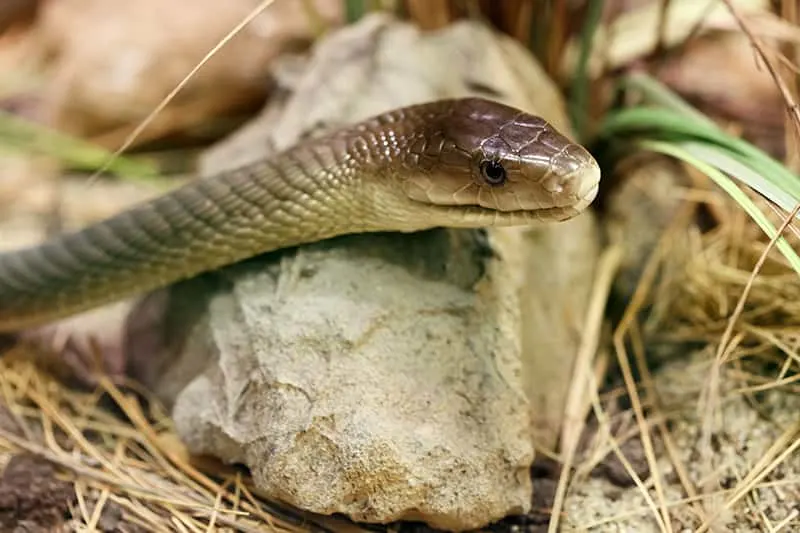
History:
Albert Gunther, a German-British naturalist, was the first European to write about the Black Mumba in 1964.
Africa has several myths about the Black Mamba.
In one story, it is said that Black Mambas chase horses, men on horseback, and humans. Another legend describes how a Black Mamba swung down from a tree to bite and kill 5 cows.
The legend of Ndlondlo is about a Black Mamba with a feather on its head. It is said that Ndlondlo strikes so fast that the movement makes the feather whistle. Another story tells of Ndlondlo hiding itself in the bush while pretending to cry like a baby. When people come to look for the baby Ndlondlo attacks them.
There is no proof that Black Mambas chase prey, hunt big animals, or lure humans into traps.
Predators
Black Mambas are prey for eagles and other large birds. Mongoose are also notorious snake predators. Habitat loss is the main threat to Black Mambas.
None of these threats have impacted the Black Mamba population yet.
Lifespan: Black Mambas live up to 11 years in the wild and more than 20 years in captivity.
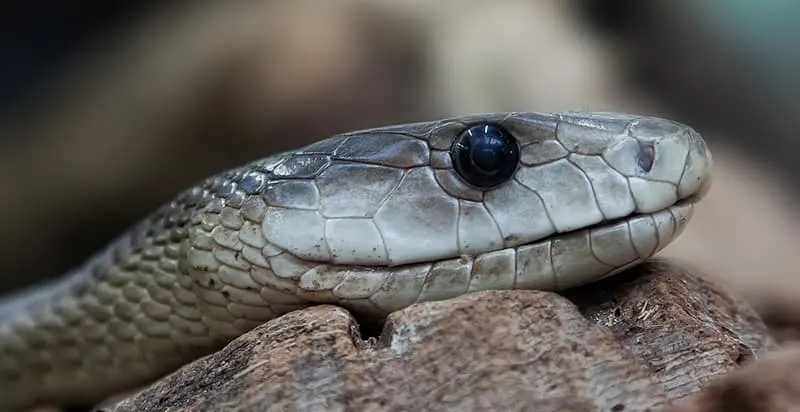
25+ Surprising Facts about Black Mambas
- The Black Mamba is the longest venomous snake in Africa.
- The Black Mamba is the second-longest venomous snake in the world.
- The King Cobra is the only snake that is larger than a Black Mamba.
- The Black Mamba is the fastest land snake in the world.
- Black Mambas are exceptional swimmers.
- Black Mambas will climb trees and drop on predators if necessary.
- Black Mambas have good vision and a highly developed sense of smell.
- Black Mambas are very patient and will wait for the perfect moment to strike prey.
- Male Black Mambas will slither several miles to find a mate.
- It is believed the Zulu word “imamba” is the source of the word “mamba.”
- Black Mambas are also known as Black-mouthed mambas, Southern brown mambas, or Swart mambas.
- Black Mambas are among the top 10 most venomous snakes in the world.
- A Black Mamba is five times as venomous as a King Cobra.
- Black Mamba males fight by twisting around each other to wrestle the opponent to the ground.
- Some people believe that a giant Black Mamba guards a mountain range in Africa.
- Some people believe that a Black Mamba can balance on its tail.
- Some people believe that a Black Mamba bites its tail to become a loop and roll down a hill to attack.
- One is more likely to see a black mamba from March to April after the first summer rains.
- The Black Mamba's venom affects the nervous and cardiovascular systems. The venom is called a neuro-cardio toxin.
- Black Mambas can live at elevations of up to 5,900 feet, but they prefer low-lying areas.
- Black Mambas are adaptable and can live in swamps, woods, forests, and savannahs.
- Locals in South Africa call a bite from the Black Mamba “the Kiss of Death.”
- Black Mambas are diurnal (daytime) predators, so they are easily seen.
- A Black Mamba moves sideways in an “S” shape by pushing off objects in its path.
- Mambas don't have ears, but they detect the ground's vibrations.
- A female Black Mamba will strike at the male if he doesn't leave immediately after mating.
- The Black Mamba is near the top of the food chain of its natural habitat.
- Black Mambas can fold their fangs up into the roof of their mouths.
- The Ocellated Carpet Viper has killed more people than all other African snakes combined.
- A Mamba will attack anything that prevents it from entering its burrow.
We hope you enjoyed learning all about Black Mamba snakes. Did you learn anything new? Share with us any other interesting facts you know about Black Mambas. We are excited to learn more.
